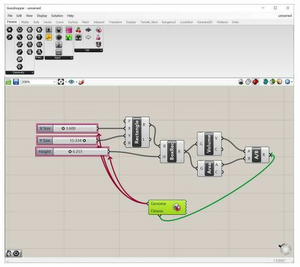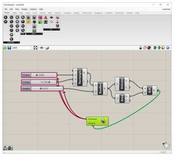Information
- Publication Type: Master Thesis
- Workgroup(s)/Project(s): not specified
- Date: 2022
- Open Access: yes
- First Supervisor: Hannes Kaufmann
- Pages: 75
- Keywords: Many-objective optimization, Multi-objective optimization, Evolutionary algorithm, Automated structural layout generation, Integrated industrial building design, Flexible industrial building
Abstract
Industrial buildings often have a very short lifespan due to inflexible design of load bearing structures. Frequently changing production processes often lead to demolition of industrial buildings because these buildings cannot be adapted to the new requirements. This work is part of the BIMFlexi project, whose goal is to develop an integrated Building Information Modeling (BIM) based platform to connect all stakeholders in a building planning process to design flexible and sustainable industrial buildings. In this work a many-objective optimization tool is presented to support decision makers during the design phase. The tool is built on top of a parametric framework for load bearing structure generation. By presenting multiple optimized load bearing structures with different properties decision makers can make informed decisions about trade-offs between cost, environmental impacts and flexibility of a load bearing structure. The tool has been studied in two different ways. A user study was conducted to verify its usabilityand usefulness. A second study compared three different evolutionary algorithms to find the best fitting algorithm for industrial building optimization.Additional Files and Images
Weblinks
BibTeX
@mastersthesis{wang-sukalia-2022-mom,
title = "Many-Objective Optimization for Maximum Flexibility in
Industrial Building Design",
author = "Xi Wang-Sukalia",
year = "2022",
abstract = "Industrial buildings often have a very short lifespan due to
inflexible design of load bearing structures. Frequently
changing production processes often lead to demolition of
industrial buildings because these buildings cannot be
adapted to the new requirements. This work is part of the
BIMFlexi project, whose goal is to develop an integrated
Building Information Modeling (BIM) based platform to
connect all stakeholders in a building planning process to
design flexible and sustainable industrial buildings. In
this work a many-objective optimization tool is presented to
support decision makers during the design phase. The tool is
built on top of a parametric framework for load bearing
structure generation. By presenting multiple optimized load
bearing structures with different properties decision makers
can make informed decisions about trade-offs between cost,
environmental impacts and flexibility of a load bearing
structure. The tool has been studied in two different ways.
A user study was conducted to verify its usabilityand
usefulness. A second study compared three different
evolutionary algorithms to find the best fitting algorithm
for industrial building optimization.",
pages = "75",
address = "Favoritenstrasse 9-11/E193-02, A-1040 Vienna, Austria",
school = "Research Unit of Computer Graphics, Institute of Visual
Computing and Human-Centered Technology, Faculty of
Informatics, TU Wien",
keywords = "Many-objective optimization, Multi-objective optimization,
Evolutionary algorithm, Automated structural layout
generation, Integrated industrial building design, Flexible
industrial building",
URL = "https://www.cg.tuwien.ac.at/research/publications/2022/wang-sukalia-2022-mom/",
}

 Master thesis
Master thesis

